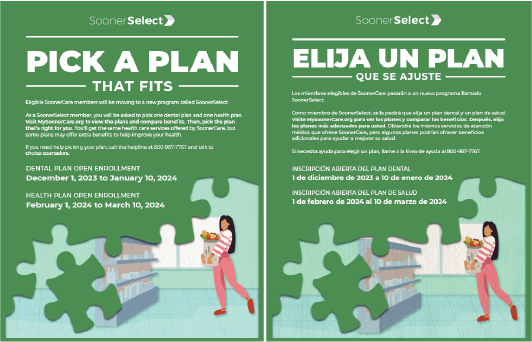December 2023

Most SoonerCare members will get their health care services covered in a new way next year – through SoonerSelect dental and health. Enrollment for the dental plan is open now through Jan. 10, 2024. Health plan open enrollment will take place from Feb. 1-March 10, 2024.
SoonerCare members who are transitioning to SoonerSelect are asked to review the dental plans and select the one that is right for them. If they don’t select a plan, OHCA will choose one for them.
Please remind your patients that it’s important they review these plans. They should compare benefits and, if they have a dentist they want to keep, they should pick the plan that has that provider in the plan’s network.
Visit our SoonerSelect page to learn more. You can also download free Pick a Plan flyers to hang in your office. Flyers are available in English and Spanish.
SoonerSelect Dental coverage is scheduled to start on Feb. 1, 2024, and SoonerSelect Health and Children’s Specialty Program coverage is scheduled to start on April 1, 2024. Current SoonerCare members continue to be eligible for dental and medical benefits through SoonerCare until they switch to SoonerSelect coverage at that time.
Members with questions can visit the SoonerSelect FAQ page or call the SoonerCare helpline at 800-987-7767 to talk to plan choice counselors.
Provider Information
To ensure all provider files are up to date, OHCA reminds you to log into the secure provider portal and confirm that your address, contact information and other demographic information is correct. This information can be checked and corrected by selecting the “update provider files” link once logged in to the admin account. For more information on how to update the provider file, please view the SoonerCare Provider Contracts presentation on OHCA’s Training Page or email SoonerCareEducation@okhca.org.
Provider Renewals
The provider types below are open or will be opening for renewals soon. Please be sure to log in to your provider file and complete the renewal process prior to the expiration date. Failure to do so may result in denial of payment after the expiration date.
-
Physician Assistants
Open for renewal on Nov. 17, 2023, and will expire on Jan. 31, 2024.
-
Licensed Behavioral Health Practitioners
Open for renewal on Dec. 15, 2023, and will expire on Feb. 28, 2024.
OHCA will be hosting a provider education webinar on the Quality Improvement Fluoride Varnish (QIFV) project at 2 p.m., Tuesday, January 16. Be sure to check the provider training page for registration details coming soon.
Early childhood caries is the most common chronic childhood condition and is largely preventable. Did you know it is five times more common than asthma and seven times more common than hay fever?
The U.S. Preventive Services Task Force recommends that primary care clinicians apply fluoride varnish to the teeth of all infants and children starting at the age of primary tooth eruption and continuing through age 5. When used at least twice a year, fluoride varnish reduces dental decay by a third.
Although SoonerCare reimburses for fluoride varnish application in the medical clinic, the utilization rate remains low. Provider surveys showed barriers to use include staffing, time and training.
The QIFV project researched Oklahoma clinics that are successfully incorporating fluoride varnish into the well-child check, mapped their workflows, and applied the findings to volunteer clinics. Results of the project and feedback from participating clinics can help improve the use of fluoride varnish, demonstrate the financial benefits to providers, and reduce the barriers to workflow integration.
Webinar topics will include:
- Initial findings from the OHCA Quality Improvement Fluoride Varnish project.
- Integrating oral health prevention into the primary care well-child visit.
- The use of fluoride varnish in prevention of childhood caries.
- Workflows from clinics who have successfully integrated fluoride varnish into the well child check.
- Techniques to incorporate fluoride varnish into the primary care and pediatric settings.
- Evidence from trending data graphs.
The webinar will be live with a question-and-answer session immediately after.
SoonerCare eligibility reviews are ongoing. Those members who are no longer eligible are having their coverage ended in phases.
Please continue to check eligibility and ensure there is a current prior authorization on file for the member before delivering treatment-planned services. Eligibility must be verified on the service date before services are rendered. When checking eligibility on the provider portal, a single service date must be used; date span searches will not provide accurate information. Questions? Contact the Provider Helpline at 800-522-0114 or SoonerCareEducation@okhca.org.

The holidays can be stressful, and stress can trigger tobacco cravings. If you have patients who are looking to quit or who have already quit, helping them manage stress can drastically improve their odds of success. Here are five stress-management tips to pass along to your patients:
-
Plan ahead: Bring distractions and nicotine patches, gum or lozenges just in case.
-
Set boundaries: Let friends and family know you are quitting, and don’t be afraid to say “no.”
-
Stick to healthy habits: Stay active, drink water and get plenty of sleep.
-
Enjoy some alone time: Set aside a few moments for self-care throughout the holidays.
-
CELEBRATE: Quitting tobacco is a BIG deal. There’s no better time to celebrate such a life-changing decision!
Find more stress-management resources to pass on to your patients.
FREE Quit Support for Every Patient
When you talk with your patients about quitting tobacco, bring up the Oklahoma Tobacco Helpline. Whether your patients are quitting for the first time or the eighth time, the Helpline has free services to help them quit. Your patients can order their free supply of patches, gum or lozenges and track their progress in personalized dashboards. They can also chat with a coach via email, receive encouraging text messages and participate in live online group sessions to connect with a community of peers. Explore the free services.
FREE Office Materials for You
The Helpline’s free office materials can help you start the conversation about quitting tobacco. Clipboards, badge reels, pens, prescription pads and more are great ways to bring attention to the Helpline’s free resources. Order your free Helpline materials.

Q: How should I describe patient goals in the physical therapy setting?
Per guidelines, goals should use the following format:
- Name the person (or their role) and the activity they will complete.
- Specify the exact timeframe in which you expect the activity to be completed.
- Describe the conditions under which the activity is expected to be completed.
- Provide the clinical rationale for the goal.
- Predict the prognosis. If re-evaluation is planned, provide comments describing current level of achievement and/or abandonment/modification.
Example: Dar will elicit ability to perform the single leg hop test for at least 75cm for the R. LE by 6 months without compensatory movement patterns suggesting good synergistic LE muscle activation for a safe return to age-appropriate activities and participation in high school basketball. (Current Progress: began today; Prognosis: excellent)
Q: Is my requested date span for coverage correct?
-
Initial Evaluation:
You may request a timeline (from <start date> to <end date>) consistent with the referring provider’s script. If the referring provider does not specify a date range (i.e., just an eval and treat script), you may request a timeline consistent with your assessment and clinical judgment. In the latter case, do not exceed an end date beyond 12 months from the date of the provider’s script.
-
Re-Evaluation or Progress Note:
Be certain that the timeline (from <start date> to <end date>) of the previously approved PA does not intersect the new timeline for which you are requesting coverage. This would be considered an “overlapping validation” and your PA request would be canceled. You need at least 24 hours between the previous end date and the next start date.
Example: A PA was approved from 02/01/23 to 05/01/23. The new request cannot start on 05/01/23 or any date before it. A new request could be from 05/02/23 to 08/01/23.
Q: Can my SLP graduate student intern sign documents?
Yes! Graduate students are permitted to sign evaluations, progress notes, plans of care, and daily notes. However, a fully certified, contracted therapist must cosign with them and add a note certifying they provided supervision and also attest to the accuracy of the assessment, treatment plan, and/or services rendered by the student. The graduate student must sign in a way that clearly designates they are a graduate student intern.
Q: What documentation should I submit if I am requesting continued services or additional units?
For continued services or additional units, you must include patient-specific, clinically significant details related to the progress of goals, including levels achieved or details as to why goals were not previously met. A progress note and a discharge plan must also be provided.

The holidays are the perfect time to spread some cheer, and what better way than to help someone live more independently by donating gently used Durable Medical Equipment to our Device Reutilization Program? Currently, our waitlist is full of folks waiting for blood pressure monitors, grab bars, and shower chairs.
Oklahoma ABLE Tech's Reutilization Program staff retrieves donated devices and works with vendors to repair equipment to ensure peak performance. All donated durable medical equipment (DME) is sanitized, refurbished, and reassigned to the best-matched Oklahoman. Complete the Authorization for Donated Equipment form to schedule a free drop-off or pick-up.
|
Anxiety is less common among pediatric patients than adult patients; however, a significant percentage of children are still affected. Nearly 10% of children ages 3 to 17 years were diagnosed with anxiety from 2016 to 2019 according to the Centers for Disease Control and Prevention. Anxiety can impact a child’s social life, school performance, and their overall wellbeing.
While treatment includes lifestyle modifications, patients often require psychotherapy and/or pharmacotherapy to manage symptoms. Some antidepressant medications are recommended for the treatment of pediatric anxiety; however, they carry a potential risk of suicide and should be used with caution. In particular, paroxetine carries an increased risk compared to other agents in its class. If medications are used as part of a treatment plan, they should always be tapered if discontinuation is needed.
Anxiety Treatment Recommendations
Children Ages 3-5:
Psychotherapy:
- Recommended to be used before pharmacotherapy due to a lack of efficacy and safety data for pharmacotherapy and positive data for psychotherapy in older children.
Pharmacotherapy (after ≥12 weeks of psychotherapy):
- 1st line: Fluoxetine
- Initiation: 8 to 10 weeks
- Continuation: up to an additional 6 months
- 2nd line: Fluvoxamine (after 8-10 weeks of fluoxetine)
- Initiation: 8 to 10 weeks
- Continuation: up to an additional 6 months
Children Ages 6-18:
Psychotherapy:
Pharmacotherapy (after ≥12 to 20 sessions of psychotherapy):
- 1st line: Selective Serotonin Reuptake Inhibitors (SSRIs)
- SSRI medications with the strongest efficacy and safety data are:
- Fluoxetine
- Escitalopram
- Fluvoxamine
- Sertraline
- Initiation: 6 to 8 weeks
- Continuation: ≥12 months after remission of symptoms. Reassess use beyond this 12-month period.
SoonerCare provides coverage for several related screening tools and antidepressant medications. Additional information can be found on the Behavioral Health and Substance Abuse Services website. For SoonerCare medication coverage-related questions, including antidepressant medications, please contact the Pharmacy Help Desk at 405-522-6205, option 4, or toll-free at 800-522-0114, option 4.
|